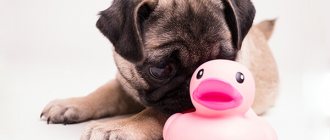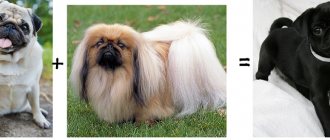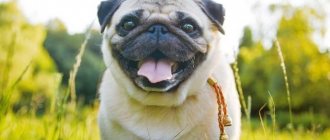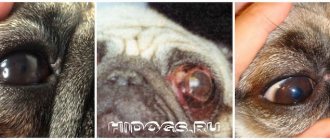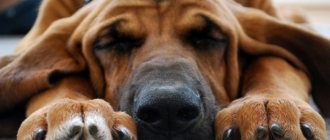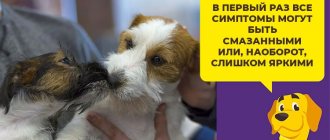Some dog breeds can only be kept by wealthy people. After all, some animals need to be fed intensively, while others, due to their decorative characteristics, are not cheap. A pug is a small dog that previously could only be known. It is believed that the origin story of this cheerful dog originates from sunny China.
True, in those distant times the breed was called “Ha Pa” and “Lo Jie” instead of the current pug. Maybe someone will doubt the Chinese roots of pugs, but there are reasoned explanations for this.
Early manuscripts by Chinese scholars describe varieties of "small dogs with an almost square muzzle." And such characteristics directly indicate the relationship of those animals with today’s decorative pugs.
Miniature pugs can easily be kept in small city apartments. In addition, the animal gets along well with people and other animals. Puppies are not cheap, but there is a chance to buy a pet for your soul at an affordable price.
Origin story
In fact, experts do not have accurate evidence of the real origin of pugs. In addition, there are several plausible theories about the origin of the breed, the most likely being that the dog genus began in China.
The ancient dogs, called Ha Pa by the Chinese, had long hair. The Luo Jie were similar to the Pekingese, but they had shorter hair. Dogs were considered sacred animals and lived only in the homes of noble people in China. Some representatives of that breed lived on the territory of the imperial palace, which explains the privileged position of the dogs.
There are also other global similarities between today's representatives of the breed and their progenitors. In ancient times, pugs did not have such pronounced wrinkles in the muzzle area, but there were folds in the eyebrow area. The Chinese saw certain signs in this - similarities with some hieroglyphs. And such characteristics for ancient people are nothing more than signs that a dog belongs to a high rank. These important features were taken into account when breeding animals in those days.
When trade and diplomatic relations between the continents began to improve, Luo Jie entered European territory. It is believed that it was during those periods that there was a massive surge in the popularity of pugs. Not only important nobles, but also the common population began to have them in their homes. By the way, the dogs imported from China received their name from the Dutch - Chinese Mastiff.
Pugs became a separate, officially recognized breed only towards the end of the 15th century. Back then, miniature representatives of the canine family could be found in the company of noble ladies - at balls and social events. Back then it was very fashionable to carry around a pet with exclusive external characteristics. In addition, pugs kept their owners warm in bed on cold nights.
During the reign of Emperor Napoleon, pugs enjoyed incredible fame. This is due to the fact that Napoleon’s wife Josephine had a favorite – the pug Fortuna, with whom she almost never parted.
But when the French Empire fell, the little dogs fell into disgrace. True, after a while they still regained well-deserved popularity among the ordinary population.
Individuals with modern external characteristics appeared in England. They were formed from representatives of the breed who had:
- ears cropped short;
- tails curled in different directions;
- elongated muzzle.
The flat nose and square format are the result of long-term breeding work. The improved breed was presented at an English exhibition in the 80s. It was then that the first club of breed lovers appeared. A little later, breed standards were established and officially recorded.
Now pugs can be found everywhere - at any international exhibitions and competitions. The breed is common in many countries of the world.
The tail doesn't interfere
Remember the children's fairy tale about a fox whose tail prevented him from running away from hunters? Taking offense at him, the fox stuck him out of the hole and... the hunters pulled her out without any difficulty. So, a tail that gets in the way is not about a pug. He has it tightly twisted into two rings and pressed tightly to his back. In any case, that's how it should be. But there is only one ring. It is believed that if a dog untwists its tail, it means that it is not feeling well.
By the way, the tail is covered with longer hair, but this is not mentioned in the standard. It is also kept silent about the fact that pugs generally have double hair. Closer to the body there is a soft, delicate undercoat. It is somewhat shorter than the guard hairs lying on top. Disadvantages include too thick undercoat or too sparse coat. In both cases, the pug doesn't look his best. It's either some kind of hedgehog or a soft chicken.
To summarize: according to the standard, the coat should be thin, smooth, short and shiny.
Description of the breed
The pug has a proportional build. Body format is square.
The head breed standard is represented by the following characteristics:
- The large round head is a continuation of the not too long, thick and massive neck. The dog's scruff is moderately pronounced.
- If you look at the dog from the front, you can see that the skull is flat between the ears. The forehead does not protrude at all above the eyebrows;
- the muzzle is short, one might even say flattened. Its width is equal to the width of the forehead. The fleshy nose is colored black. The nasal passages are somewhat shortened, but not curved;
- The straight bridge of the nose is not very pronounced. If it is completely absent, the dog will experience difficulty breathing and cardiac activity;
- wrinkles in the skull area form a symmetrical, beautiful pattern. The location of the folds is near the eyebrows, above the nose;
- The jaw is wide, the chin is pronounced. The lower incisors are arranged in a dense, even line; they overlap the upper row of front teeth. A pug is able to bite an object no more than 3 mm thick;
- brown eyes are located in line with the nose. They are large, convex, round. If a pug's eyes are slanted, almond-shaped, then the individual will be considered defective;
- Small, high-set soft ears lie close to the skull. They can be of two types - “rose”, when the soft tissue is pulled back, revealing the inside of the shells, and “button”, in which case the ears are laid forward, covering the ear canals.
The dog's stocky body is well developed. The length is almost equal to the height of the animal at the withers. The height of an adult is 28-32 cm. Body weight varies between 6.5 -8.2 kg.
The body characteristics of a pug dog are described as follows:
- wide chest with springy, strongly curved ribs. The extreme point of the ribs should be located below the level of the elbows. Towards the back of the dog, the chest line is slightly pulled up;
- the forelimbs are located at a distance, but parallel to each other and perpendicular to the body. From the outer corner, strong muscles form a smooth arc. Shoulders are rounded. The shoulder blades are laid back, forming an acute angle of 45° with the line of the back;
- The hind limbs have a similar arrangement to the forelimbs. True, the hock joints of the dog are significantly pronounced;
- The dog's full croup is rounded. The thick caudal process is located high. It is shaped like a ring and pressed close to the body. Double twist is considered an advantage. The entire tail is covered with short, stiff hair.
Pugs have hard, smooth and shiny hair. The undercoat is dense, but quite soft.
Pug coat color can be:
- black;
- fawn;
- gray-platinum;
- beige;
- deer (a darker stripe runs down the back of a dog with apricot-colored hair).
Representatives of the breed with light-colored fur have a characteristic black mask on their muzzle. Also, light-colored individuals have black markings on the cheeks, ears, forehead, from the withers to the tail.
Dark-colored pugs have much coarser fur than light-colored pugs. If the dog is black, then its skin has a blue tint. Some individuals have no undercoat at all.
Pugs' skin is quite elastic. It doesn't droop, but it doesn't stretch either. Covers fairly developed strong muscles. Pug dogs move elegantly and smoothly. The steps are free and springy.
Each breed has its own special nicknames. After all, the name describes its owner, his character, and emphasizes his virtues. So, for pug boys, nicknames that are easy and clearly pronounced are optimal. For example: Archie, Ricky, Bruce, Jai, Gucci. Pug girls can be called: Ricci, Elsa, Teza, Cleo, Shelly.
And again geometry
The pug's head is still the same square in shape. The area between the ears is almost without bending. And if you draw a line through the center of the eyes and divide the muzzle in half with another line, you get the ideal position for the top of the nose. It is characterized only by black color. Modern requirements require large and fully open nostrils. If they are narrowed, you can expect a serious decrease in scores. And it will be difficult to breathe with such nostrils.
In order for the entire muzzle to look wide, which is also emphasized by the standard, the dog must have a wide lower jaw and forehead. Changing their size leads to visual deformation - the “face” becomes narrowed or widened in the top-bottom direction, which violates the shape of the square.
The line of the bridge of the nose is of great importance for the expression of facial expressions. If it is concave, then the pug becomes snub-nosed. And if it is bent, then it seems that the dog is about to cry. So the line of the nose is just straight, as if drawn with a ruler.
A pug's eyes are dark, shiny spheres. In them you can read the tenderness of character, guess a desire or see a perky spark. They are actually very expressive. It is considered a fault if the eyes are located close to each other, then the overall expression of the muzzle becomes somewhat stupid. But this happens extremely rarely. Much more often, pugs have light-colored eyes or eyes that are too bulging, slanted, or with too prominent whites. For an excellent exterior, these are too noticeable flaws and they are not acceptable.
Character
The pug is a noble, affectionate, friendly and balanced dog. She has a cheerful disposition and love of life. For the most part, pugs are loyal to all members of their family. It is extremely rare to find cowardly, dissatisfied and aggressive individuals. But for the most part, a dog’s anger is due to improper upbringing.
Pugs get along well under the same roof with children. Also, representatives of the dog family get along well with other family pets. Small dogs love attention very much, so they will always try to please their owner and be the first in everything.
Fans of the pug breed claim that dogs with dark coat color are more alert and balanced. Light individuals have a simpler and kinder character.
What holiday is it?
Every year, on October 15, all lovers of small dogs with a mischievous disposition and sad faces are united by one holiday - Pug Day!
When did it appear?
It is not known for certain who and when exactly came up with the idea of celebrating this holiday, but there is a version that the origins date back to the 16th century. At that time, dogs of this breed were especially popular among the nobility - paintings were dedicated to them, they were regularly mentioned in chronicles and, in general, it was considered that keeping a pug was very aristocratic.
Social events were held, at which each guest brought his little pet with him. Such an event was conventionally called “Pug Day” and later, this holiday became popular among the people and has survived to this day.
Another version says that the holiday is associated with the opening date of the first official club for pug lovers in 1884.
How to celebrate?
There are no direct traditions regarding how and where to celebrate this date. Some owners throw a party for their dog, buying it treats, toys and dressing it up in funny outfits. Others meet with familiar pug owners so that their pets can play together.
For many active Internet users, Pug Day has become a good tradition of taking funny family photos with their pet.
Reference! In 2021, a “Pug Parade” was held in the park named after Pavlik Morozov, dedicated to International Pug Day! The owners walked their dogs in funny costumes and elegant dresses for a good purpose - to raise funds for the private shelter “Pugsodom”.
Care and maintenance
The pug has a fairly compact size, so keeping such an animal in an apartment does not cause any particular difficulties for humans. True, street walks with a pet should be at least 1 hour at a time. And there should be at least two walks per day.
The pug requires almost no physical activity, although running gives the dog pleasure. The active part of the walk should take no more than 30 minutes. If the weather is too cold or, conversely, hot, then you can limit running activity to 10 minutes. The rest of the time, walk slowly, take a walk, or just relax.
The dog can be trained to relieve itself at home. To do this, you should determine the location of the toilet, the type (diaper, tray, newspaper), and show it to the puppy.
A pug should be housetrained from an early age. If the case is successful, praise the dog. If your pet fails to pee in the designated area the first time, then there is no need to scold him for it. The owner should be patient and show the toilet every time the puppy goes by.
Pugs shed 1-2 times a year. Lasts 2-3 weeks. If the room where the pet lives is dry and excessively warm, the fur can fall off all year round. It is important to provide the dog with a comfortable atmosphere in the living space:
- air temperature – 20-23°C;
- humidity at 45-65%.
If all the conditions are met, but the dog’s hair continues to fall off, you should pay attention to the frequency of washing. According to the rules, she does not require frequent water treatments using shampoo. It is enough to bathe your pet 2-3 times a month. You can use detergents and cosmetics even less often - once a month is enough.
You need to brush your dog with a special brush once a week. Thus, dead hairs and skin flakes are removed, and subcutaneous blood circulation is stimulated. During the shedding period, the amount of brushing should be increased.
Excessive hair loss can also be caused by body problems: the appearance of helminths or subcutaneous parasites, disorders of the digestive system, and pathologies of other organs.
On the face, food particles or dirt from the street may remain in the folds. This may cause an unpleasant odor. A couple of times a week you need to wipe the dog’s skin with cotton pads soaked in boiled water. After this, wipe the fold dry with a towel. You cannot wipe away wrinkles every day. This can cause the skin to become dry and lead to infection.
The dog's eyes are quite healthy. Sometimes you can notice the release of a whitish liquid from the corners - this is the release of dust and dirt that has accumulated on the shells during the day. The liquid should be carefully removed with a damp cotton pad or cloth.
The dog's nails need to be trimmed once a month. If you do not treat the claws, they will painfully dig into the dog’s fingers, causing discomfort.
If suddenly redness, large suppuration, or a whitish spot appears in your pet’s eyes, you should immediately contact a specialized clinic; you should not carry out independent treatment at home. The same should be done if a dog is found to have a tick on its body or in its ears. Delayed assistance may not save your pet from encephalitis.
Feeding
Pugs have a tendency to be overweight. Therefore, you should carefully monitor your pet’s diet. You can feed your animal both ready-made food and home-cooked food. There is one rule: you cannot mix two types of feeding at one time.
If the choice is made in favor of ready-made food, then it is better to give preference to premium products, for example, Royal Canin. They already contain the necessary vitamins and minerals, and are also balanced according to all the rules.
When feeding your dog natural foods, you should pay attention to healthy foods:
- lean meat (beef, venison, rabbit);
- offal (kidneys, liver, heart), doused with boiling water;
- cereals (rice, buckwheat);
- fresh vegetables and fruits;
- fermented milk products;
- sea fish, provided there are no bones in it.
You should not give your pug:
- sweets;
- baked goods;
- cocoa products;
- legumes;
- fatty, spicy, salty and smoked foods;
- river fish;
- bread and pasta;
- oatmeal;
- any kind of bones.
All of the listed products will disrupt the proper functioning of the gastrointestinal tract. Sweets and flour products will provoke the formation of excess weight.
What to feed a puppy
If an adult pug should eat 1-2 times a day, then for puppies the meal plan is slightly different:
- After switching from mother's milk to familiar foods, you need to feed the puppy 6 times a day in small portions.
- After 2 months, the dog is fed 5 times a day. The serving size increases by 100-200 grams.
- From 4 to 6 months, the puppy eats 4 times a day.
- Before reaching the age of one year, the dog requires 3 feedings a day.
- After a year, the stage of active growth of the animal ends. The pug switches to the adult dog mode - 1-2 meals a day.
It is best to feed pug puppies with ready-made premium and super-premium products. Manufacturers have already taken into account all the needs of a growing organism and balanced the composition. In addition, pugs are prone to allergic reactions, and among premium nutrition you can easily find holistic ones.
The judges don't like the waddle gait
Let's return to the description of appearance. The pug's neck resembles a comb. It gives a proud posture and allows you to hold your head high. But the neck cannot be too long, otherwise the dog will seem awkward.
Now let's turn our attention to the legs. Both the rear and the front - they are necessarily parallel to each other. The front ones are spaced so as not to narrow the chest. The shoulders slope beautifully. It is considered ideal if the shoulder blade and humerus are equal in length. And the angle between them will be 90 degrees. This indicator affects the correctness of movements, so it will not go unnoticed. Running and gait should be completely free, as if springy, but in no case mincing.
The standard did not define angles for the joints of the hind limbs. But according to generally accepted canine anatomy, the pelvic bones tilt toward the ground at an angle of 30 degrees. And with the thigh they form a right angle. It is these degrees that will give a good push when jumping. Also, the modern standard omits the proportions of the thigh and lower leg. Here experts take the principle of biomechanics as a basis. Their equal length is considered normal.
Among the disadvantages for the forelimbs, we note that they are turned inward or outward. For the hind hindquarters, close hock joints and a side-to-side stance are unacceptable. The judges don’t like the waddling gait at all, or simply whether the pug’s legs are thick or thin. And they also pay attention to the gait. Ambling is unacceptable, that is, if the dog takes a step simultaneously with two right legs and then with two left ones.
Training and education
Miniature dogs are very attached to their owners. They also always try to please their owner. Therefore, training a pet will bring pleasure not only to the animal, but also to the dog breeder.
At a young age, during educational play, a dog may try to misbehave, but you should not scold it for this. For the sake of a piece of treat or a kind word (look) from the owner, pugs are ready to complete assigned tasks.
To keep your pet healthy and happy
The pug dog breed, like any other breed that has lived under human care for thousands of years, cannot exist without care and careful care. It is not difficult to do, but it is necessary. Pugs can only live indoors, they are afraid of both heat and cold, and cannot stand dirt. Walking outside the city, in thick grass or on a dusty road is not for them; unprotected eyes can become damaged or clogged. In the city, it is necessary to walk in order to develop muscles and avoid obesity, but you need to walk slowly and not for long, if possible, then - on the rise, with a tight leash. For those who like to run and frolic with a nimble pet, it is better to get something faster-footed . Surprisingly, many of these dogs cannot swim. The coat is short, but during shedding it needs to be combed. Ears, eyes, folds on the face - all this requires regular cleaning. Approximately once every two months, a clean dog should be bathed. The appetite can be excellent, leading to obesity, but if a reasonable owner does not overfeed the pet and often takes it for walks, this does not happen.
The oldest breed of dogs, the pug, is an ideal companion, good-natured, loyal and calm, the best qualities characteristic of indoor pets are brought to perfection.
Diseases and life expectancy
The life expectancy of small dogs is 13-16 years. Under good living conditions, a pet can live several years longer than the average upper limit.
Diseases to which representatives of the pug breed are susceptible:
- obesity;
- dental diseases;
- infections that occur in skin folds;
- respiratory tract pathologies;
- ophthalmological problems;
- seasonal allergies.
It is noted that this type of breed is prone to epileptic seizures.
How much should an adult pug weigh?
The ideal weight of a dog is not an end in itself for its owner. This is a real concern for her health. Extra pounds lead to many serious pathologies, including: impaired respiratory function, diseases of the cardiovascular system and joints, diabetes. Excess weight also leads to a reduction in your pet's life expectancy.
The weight of an adult pug dog should be between 6 and 8.5 kg. This value is average, since each breed standard has its own value. For example, in the International European Standard FCI - from 6.3 to 8.1 kg. In the American AKC standard - from 6.35 to 8.16 kg. The Canadian and English Kennel Clubs (CKC and KC) agree with the FCI standard; they indicate the ideal weight of an adult pug from 6.3 to 8.1 kg.
Important: if the weight of an adult dog is higher than that specified in the standards, it must be examined for obesity.
Estrus, mating, pregnancy and childbirth
Breeding pugs is not recommended for beginners. After all, this process has a lot of subtleties:
- Before mating, you need to take care to rid your pet of excess body weight. A month before mating, the dog should be given antihistamines.
- The first mating is allowed at the age of no earlier than 10 months. The more the dog gets stronger before mating, the better. Therefore, some breeders believe that 10 months of age is too early for such a serious process.
- After the heat comes, you need to wait 10-15 days, and only then breed. This is the best time to fertilize a bitch.
- In order for the mating to be successful, it is necessary to give the dogs time to get to know each other. For successful fertilization, mating is repeated after three days.
Incorrect crossbreeding can result in animals with characteristics that are far from standard.
During pregnancy, the bitch should be provided with adequate nutrition. There is no need to increase the number of feedings; you just need to supplement the diet with various microelements.
Your dog may need help during the birthing process. Therefore, a pregnant pug should be observed by a specialist. The owner must listen to the advice of the veterinarian if he wants to get healthy offspring from his ward.
Pug weight by age: table and average data
To understand how a pet develops, you need to constantly measure its weight and height and correlate these indicators with those indicated in the table of pug weight by age. According to generally established breed rules and standards, pugs should be neither thin nor fat. The dog's physique should be harmonious and have a balanced ratio of weight and height at the withers. At each age these indicators will be different.
Pug weight table by month:
| Pug age | Weight |
| 1 month | 1 kg |
| 2 months | 2 kg |
| 3 months | 3 kg |
| 4 months | 4 kg |
| 5 months | 5 kg |
| 6 months^ | 6 kg |
| 7 months | ~ 6.3 kg |
| 8 months | ~ 6.6 kg |
| 9 months | ~ 6.9 kg |
| 10 months | ~ 7.3 kg |
| 11 months | ~ 7.6 kg |
| 1 year | 8 kg |
What determines the weight and height of a pug
The size of a dog is most influenced by genetics. If at least one of the puppy's parents was large in size, there is a high probability that this pug will grow up to be large.
The second factor on which the weight and height of a pet depends is the conditions of keeping and feeding in infancy. Puppies that receive breast milk from birth until they are introduced to solid food develop faster. Such offspring can grow larger.
Let's take a closer look at the main stages of pug development and give the average indicators of its weight at this age:
- Changing teeth. The puppy's baby teeth are replaced with permanent ones. The period begins at 3 months and can last several months. How much should a pug weigh at 4 months – from 3 to 4.7 kg.
- Puberty (4-6 months). Males and females have hormonal changes as they mature. Bitches may go into heat for the first time. How much should a pug weigh at 5 months – from 3.7 to 5.8 kg.
- Completion of teeth change. At 7 months, pugs begin to grow their molars. All milk teeth (42) are replaced with permanent ones. How much should a pug weigh at 7 months – from 4.2 to 6.3 kg.
- Growing up. At 12 months, pugs are considered fully formed and mature dogs. How much does a pug weigh at 1 year - from 6 to 9 kg.
How to measure a dog's size correctly
To monitor the development and growth of puppies, they are weighed and the pug's size is measured in centimeters. It is recommended to adhere to the following frequency:
- 1-2 months – measured every 5 days;
- 2-6 months – once every 10 days;
- 6 months and older – monthly.
To weigh the pug, use regular floor scales. To do this, you must first weigh yourself without the dog, and then repeat the weighing with the dog in your arms.
Important: to obtain reliable data, all measurements are carried out at the same time before feeding the pet.
How to choose a puppy
It is clear that a puppy with excellent characteristics can only be purchased in specialized nurseries. But everyone knows that puppies in elite clubs are not cheap. Thus, purebred pug puppies are valued at 15-45 thousand rubles. In this case, the future owner will receive documents for the animal and a veterinary passport.
The best clubs in Russia specializing in breeding and selling pugs:
- Loyal Friend in Moscow;
- My Universe in Nizhny Novgorod;
- Nevsky Magnat in St. Petersburg;
- YANIN CHIC MANIFIC in Perm;
- GREYT JOY in Arkhangelsk.
If you decide to buy a pug from random people, then there is a big risk of purchasing a sick animal for a nominal fee. Physical deficiencies may not appear immediately - as the dog grows older. In addition, there is a chance to get a pet with a bunch of other hereditary diseases - after all, no one can guarantee that all the puppy’s ancestors were pure representatives of the breed.
Before choosing a specific individual, you should decide for what purpose the dog is needed:
- to participate in breeding;
- as a future winner of exhibitions and competitions;
- for living in a house, and nothing more.
In the first two cases, you should choose an animal based on its compliance with established standards; these individuals are quite expensive. Rejected pugs may have minor defects in their appearance (in color, ear placement, etc.), but will be sold at several times cheaper.
Experienced breeders believe that the best time to move a pet is 2-2.5 months. During this period, the puppies have already received some of the necessary vaccinations, and they no longer need their mother as much as in the first 1-1.5 months. Animals at this age are already socialized and are ready for new acquaintances.
Comparison of breeds
Each dog has its own advantages. People who are planning to get a pug compare the breed with other similar breeds.
Take, for example, the pug and the French bulldog. The differences between the breeds are in body weight (the weight of a Frenchie is almost twice that of a pug), height (Frenchies grow up to 38 cm), and the location of the ears (the French have erect ones). By nature, both of these breeds are friendly, affectionate, intelligent, and also tolerant of children.
Each dog has a bright personality
It is perhaps impossible to find two pugs in the world that are exactly the same in color. Everyone has something individual. Dogs of any of three colors - silver, apricot and fawn - have a black mask on their face as their decoration. And the sharper the contrast, the better. So are moles on the cheeks. The more clearly they are visible, the higher the exterior rating will be.
The mark on the forehead may look like a diamond or a fingerprint. They also have to stand out, like the dark line running from head to tail. This so-called “belt” may, in principle, be absent. But if it exists, then the fur should be darkened in this place only at the tips. Only completely black pugs do not have such decoration. This color is also allowed by the breed standard. And by the way, their fur is somewhat rougher to the touch than that of light-colored animals. For black dogs, the presence of light hairs is unacceptable. There should be no marks at all.
Each suit has its own color range. For example, for silver there are different shades of light gray tones. For apricot - a palette of cream and golden colors.
Advantages and disadvantages
The pug has a number of advantages and some disadvantages:
| Characteristic | pros | Minuses |
| Shedding | With sufficient humidity and temperature, it takes place 1-2 times a year. | Monitor humidity and prevent skin diseases |
| Contents in the apartment | Fits | Requires care and toilet training |
| Pug and children | They get along and play | |
| Get along with other animals | Friendly with all living beings | |
| Care | Minimal | |
| Security qualities | Can't cope, although he tries to bark at the sight of danger | |
| Physical exercise | Virtually not required | |
| Training | Gives in well | |
| Agility | Doesn't fit |
Overall, the pug is an excellent companion and friend. Loves affection and is devoted to his owner. The breed is suitable for passive people, as the dog requires almost no physical training.
Deviations from the norm
The correct height and weight, or size, of a pug should be carefully monitored, regardless of its age:
| Age | Weight |
| one month | 1.0 kg |
| two month | 2.0 kg |
| three months | 3.0 kg |
| four months | 4.0 kg |
| five months | 5.0 kg |
| six months | 6.0 kg |
| seven months | 7.0 kg |
| eight months | 8.0 kg |
| nine month | 9.0 kg |
| ten months | 10.0 kg |
| eleven months | 11.0 kg |
| twelve months | 12.0 kg |
The most common deviation from the norm is overfeeding a pet. Changes in size cause:
- severe shortness of breath;
- problems with movement;
- general weakness;
- excessive stress on the joints;
- lameness;
- arthritis;
- deformations of the ligamentous apparatus.
Good indicators of muscle substance or muscle hardness in a pug are achieved not through feeding, but through regular physical activity, including frequent walks and physical activity.
Quite often, pug owners try to hide bone defects or the general frailty of the animal during the feeding process . As a result, with a small head, the dog has rather thin legs, as well as a fat and unattractive loose body.
Return to content


